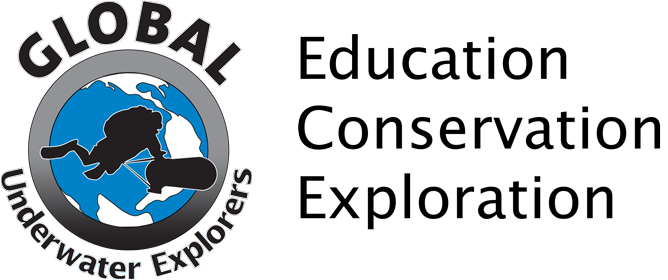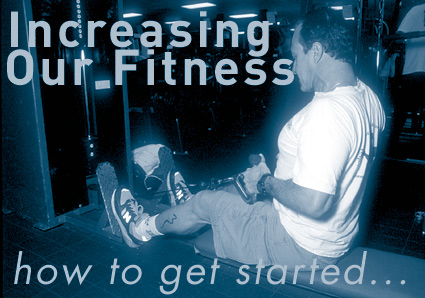Increasing Our Fitness: How to Get Started
BY CAMERON L. MARTZ, ACSM H/FI
Not all divers come from an athletic background, though most can appreciate the value that regular exercise has for diving. Just as diver training has a distinct beginning with a planned progression, so does any plan intended to increase our fitness.
Progressive Overload Training
Let us begin by defining what we're trying to accomplish when we
want to increase our fitness, whether that be cardiovascular
fitness, strength, speed, or whatever. It's called "Progressive
Overload Training," and it helps to break the phrase down in
reverse.
The training part means that we're performing activities whose purpose is to improve our fitness. We set aside time from our day to exercise; we join a health club or a running group or a swim team. We expend effort and endure discomfort in the short term to see long-term results.
The overload part means that we are asking our bodies to do more than they are usually required to do in a normal day. Our bodies respond to this overload by increasing fitness to better handle the same load in the future. Two ways that we can overload our bodies are with a higher intensity (e.g., run faster or lift heavier weights), or with a higher volume (e.g., run farther or lift more frequently).
The progressive part means that we are gradually increasing the amount that we do each day over the long term. This does not mean that we increase the amount every time we work out. Rather, we attempt to achieve a new level of performance over an extended period of time, measured best in months and years, rather than in days and weeks.
The SAID Principle
The "SAID Principle," or Specific Adaptation to Imposed Demands,
refers to how precisely our bodies adapt to the stresses they
endure. The process of tanning is the perfect example of SAID. Stay
in the sun long enough, and the skin will respond by increasing its
pigment. However, this pigmentation occurs only within those areas
receiving sunlight and in correlation to the amount of exposure. A
razor-thin line delineates areas of differing exposure.
The body's response to training is very specific, much like the
skin's 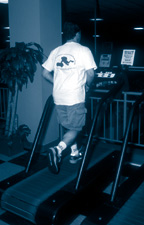 response to sunlight. Cycling improves our ability at
cycling; running improves our ability to run; and lifting improves
our ability to lift. So, the best way to get better at anything is
to do lots of that specific thing (e.g.,in the case of diving, more
diving).
response to sunlight. Cycling improves our ability at
cycling; running improves our ability to run; and lifting improves
our ability to lift. So, the best way to get better at anything is
to do lots of that specific thing (e.g.,in the case of diving, more
diving).
Of course, we know that we can supplement our direct participation in a sport with other types of training. The SAID Principle, however, tells us that exercises that mimic motions in our sport will have the greatest impact on our performance in our chosen sport. This is important to keep in mind as divers, since we have distinct fitness needs. We need muscular strength to manage our gear, and a robust circulatory system to efficiently decompress. This is why the best divers dedicate training time to lifting weights and stressing the cardiovascular system.
Strength vs. Endurance
What specific exercises constitute strength training and what
constitute endurance training? This is actually a continuum, since
every exercise will both strengthen and improve endurance. However,
some exercises emphasize one over the other. We ideally want to
include both, since they complement each other.
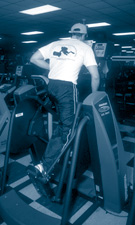 Strength training is a term that describes any kind of
training that is done with the purpose of increasing the maximum
power that a muscle can achieve. Obviously, weight training is a
part of this, but activities like sprinting, plyometrics, and hill
running can also be considered strength training. They all share in
common an emphasis on short, high intensity muscle contractions,
and result in an increase in maximum power.
Strength training is a term that describes any kind of
training that is done with the purpose of increasing the maximum
power that a muscle can achieve. Obviously, weight training is a
part of this, but activities like sprinting, plyometrics, and hill
running can also be considered strength training. They all share in
common an emphasis on short, high intensity muscle contractions,
and result in an increase in maximum power.
Endurance training is a term that describes any kind of training that is performed with the purpose of increasing a muscle's resistance to fatigue. More relevantly, exercise that uses large muscle groups for extended periods of time is typically considered "cardiovascular" endurance training. Physiological changes that occur as a result of increased cardiovascular fitness have a significant impact on our decompression (cf. Cameron Martz, Cardiovascular Conditioning and Diving Safety, Quest Vol. 1, Issue 2).
This is where activities like swimming, cycling, and running
play an 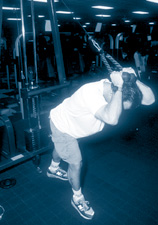 important role. When we engage in activities like
these, we are not only concerned with increasing our legs'
resistance to fatigue, we are also concerned about conditioning our
hearts and lungs. Curling dumbbells isn't going to do much towards
improving our cardiovascular fitness, since small muscle groups,
like biceps, fatigue before becoming a great burden on our
cardiovascular system. That's why it takes repetitive use of large
muscle groups (e.g.,your legs in cycling) and/or multiple muscle
groups working together (e.g.,in swimming) to improve your
cardiovascular systems.
important role. When we engage in activities like
these, we are not only concerned with increasing our legs'
resistance to fatigue, we are also concerned about conditioning our
hearts and lungs. Curling dumbbells isn't going to do much towards
improving our cardiovascular fitness, since small muscle groups,
like biceps, fatigue before becoming a great burden on our
cardiovascular system. That's why it takes repetitive use of large
muscle groups (e.g.,your legs in cycling) and/or multiple muscle
groups working together (e.g.,in swimming) to improve your
cardiovascular systems.
Is it possible to develop strength along with endurance? Absolutely, and that's exactly what we are pursuing when we incorporate weight lifting into our cardiovascular training programs.
Choosing an Activity
Enthusiasts endlessly debate which sport is "the best" for
developing fitness, but these discussions miss the point. Until you
reach a competitive level, your cardiovascular fitness depends more
on the amount of time and consistency of effort spent exercising,
rather than on how you choose to do it. The SAID Principle dictates
only that we must stress our hearts and lungs to improve our
cardiovascular fitness. Therefore, the activity that will result in
the fastest and most lasting gains in fitness will be the one that
you enjoy doing most. For some reason, many people have a hard time
grasping this seemingly common sense concept.
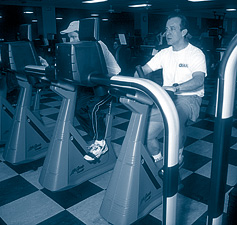 Cross training can help alleviate the boredom of a routine.
However, it is best to focus on one sport until you develop a good
base of fitness before branching out into other activities.
Besides, a good program, regardless of the sport, involves many
different types of workouts with frequent changes in schedule.
Cross training can help alleviate the boredom of a routine.
However, it is best to focus on one sport until you develop a good
base of fitness before branching out into other activities.
Besides, a good program, regardless of the sport, involves many
different types of workouts with frequent changes in schedule.
A Sample Schedule
The resources mentioned in previous articles, and on GUE's website,
will help you more than these general guidelines. However, the
templates provided below encompass much of what is truly important
when beginning any fitness program for diving.
Note that the specific days of the week listed are arbitrary. Start your program to fit around your personal schedule.
Take a day off if you feel especially fatigued from training or from any other source of stress. Repeat weeks if you do not feel ready to progress. If you must stop training because of illness or because of any other reason, go back one week for every three days off and start the program again from that point. Begin each cardio workout with a ten-minute warm-up period, and end with a five-minute cool-down. In between, maintain an intensity that is easy enough that you could hold a conversation with someone, but hard enough that you wouldn't want to.
See Quest Vol. 1, Issue 2 and the references listing therein for ideas on what to do during the weight sessions.
All rights reserved.
